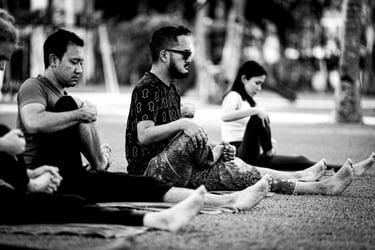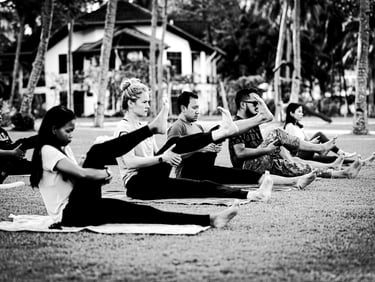Pawanmuktasana Series : A Foundation
Blood Flow: The Nutrient Superhighway
Think of your blood vessels as main pipelines, delivering oxygen and nutrients to your tissues. If those vessels are compressed, kinked by stiffness, or narrowed by inactivity, nutrient flow is compromised. This doesn't just affect energy levels—it affects your body’s ability to repair, grow stronger, and fight infection.
Pawanmuktāsana restores elasticity and flow to the circulatory system. The simple joint rotations, compressions, and releases stimulate circulation from the periphery back to the core. This primes muscles and connective tissues to receive nutrients—laying the groundwork for strength, flexibility, and recovery.
No flow, no grow. Without healthy blood supply, you can’t build strength, no matter how many Downward Dogs you do.
Synovial Fluid: The Joint Nourishment System
Your joints are fed by movement. Synovial fluid—like a nutrient-rich lubricant—needs pressure and release to flow. When you move a joint through its full range, especially with breath awareness, you’re not just “warming up”—you’re feeding the joint, maintaining its longevity, and preparing it to bear load or stretch safely.
Pawanmuktāsana systematically activates every joint group—fingers, wrists, shoulders, hips, knees, ankles. It “primes the pump” so that in later postures, joints can articulate freely and without injury.
Lymphatic System: The Immune Plumbing
The lymphatic system doesn’t just carry waste—it also circulates immune cells. It is your body’s surveillance network, and it relies on mechanical movement to function. When lymph stagnates, immunity weakens.
Pawanmuktāsana stimulates lymphatic drainage, especially in the joints where lymph nodes cluster. As you gently squeeze and release through movement and breath, you help to detoxify tissues and circulate white blood cells. This makes it a powerful support for immunity, recovery, and resilience—vital before more demanding practices like backbends, inversions, or long holds.
Nervous System Regulation: Switching On Without Stress
Unlike intense vinyasa sequences that can spike adrenaline, Pawanmuktāsana brings the body to readiness without overactivation. Its slow, rhythmic patterning is an ideal way to entrain the nervous system, promoting interoception, breath awareness, and calm energy.
This means you begin your practice already in a state of parasympathetic readiness—calm, attentive, and present. You’re more likely to move from awareness, not ambition.
Clearing the Pipes to Power the Practice
You wouldn't install new plumbing in a house with clogged pipes, or pour fresh oil into an engine with blocked valves. Similarly, moving into advanced yoga postures without proper preparation is asking your body to perform without the internal flow it needs to succeed.
The Pawanmuktasana (Wind-Relieving) series isn't just a warm-up—it's comprehensive internal preparation that creates the physiological foundation for deeper practice.
Foundational, Not Basic
In the architecture of a yoga practice, Pawanmuktāsana is the ground floor. You don’t see it once you’ve built the roof, but without it, the entire structure lacks support.
It’s not just about moving the joints—it’s about preparing the whole internal environment for transformation. From nutrient flow to immunity, from joint lubrication to mental focus, Pawanmuktāsana lays the physiological and energetic foundation for everything that follows.
So next time you guide or practise this sequence, remember: you’re not just “warming up”—you’re unclogging, nourishing, and awakening the body’s hidden systems so the rest of your practice can truly take root.




More Insights
